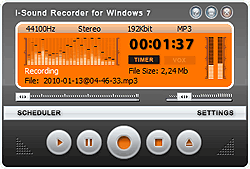Something about bitrate
Bitrate refers to the size, over time, of a video or audio stream. Although most computer oriented applications measure bitrate in terms of binary kilobits and Megabits where 1kb (1 kilobit) = 1024 bits and 1Mb (1 Megabit) = 1024 kilobits, bitrate calculations use standard metric values for these prefixes, meaning 1kb = 1000b and 1Mb = 1000kb. Bitrate calculations are typically made in kilobits per second (kbps) or Megabits per second (Mbps). They can also be expressed in other units, including bits per second (bps) or even Megabytes per second (MBps). Notice the capital B denoting Bytes. You should always use a lower case b to denote bits and upper case for Bytes.
In digital multimedia, bitrate represents the amount of information, or detail that is stored per unit of time of a recording. The bitrate depends on several factors:
- The original material may be sampled at different frequencies
- The samples may use different numbers of bits
- The data may be encoded by different schemes
- The information may be digitally compressed by different algorithms or to different degrees
Generally, choices are made about the above factors in order to achieve the desired trade-off between minimizing the bitrate and maximizing the quality of the material when it is played.
If lossy data compression is used on audio or visual data, differences from the original signal will be introduced; if the compression is substantial, or lossy data is decompressed and recompressed, this may become noticeable in the form of compression artifacts. Whether these affect the perceived quality, and if so how much, depends on the compression scheme, encoder power, the characteristics of the input data, the listener’s perceptions, the listener's familiarity with artifacts, and the listening or viewing environment.
The bitrates in this section are approximately the minimum that the average listener in a typical listening or viewing environment, when using the best available compression, would perceive as not significantly worse than the reference standard:
Audio (MP3)
- 32 kbit/s – MW (AM) quality
- 96 kbit/s – FM quality
- 128–160 kbit/s – Standard Bitrate quality; difference can sometimes be obvious (e.g. lack or low frequency quality and high frequency "swashy" effects)
- 128 kbit/s – DAB (Digital Audio Broadcasting) quality.[1]
- 224–320 kbit/s – Near CD quality.
Other audio
- 800 bit/s – minimum necessary for recognizable speech (using special-purpose FS-1015 speech codecs)
- 8 kbit/s – telephone quality (using speech codecs)
- 32-500 kbit/s -- lossy audio as used in Ogg Vorbis
- 500 kbit/s–1 Mbit/s – lossless audio as used in formats such as Free Lossless Audio Codec, WavPack or Monkey's Audio
- 1,411.2 kbit/s – PCM sound format of Compact Disc Digital Audio
Video
- 16 kbit/s – videophone quality (minimum necessary for a consumer-acceptable "talking head" picture using various video compression schemes)
- 128 – 384 kbit/s – business-oriented videoconferencing quality using video compression
- 1.25 Mbit/s – VCD quality (with bit-rate reduction from MPEG-1 video compression)
- 1374 kbit/s – VCD (Video CD) – audio and video streams multiplexed in an MPEG-PS
- 5 Mbit/s typ – DVD quality (with bit-rate reduction from MPEG-2 compression)
- 8 to 15 Mbit/s typ – HDTV quality (with bit-rate reduction from MPEG-4 AVC compression)
- 29.4 Mbit/s max – HD DVD
- 40 Mbit/s max – Blu-ray Disc
Notes
For technical reasons (hardware/software protocols, overheads, encoding schemes, etc.) the actual bitrates used by some of the compared-to devices may be significantly higher than what is listed above. For example:
- Telephone circuits using µlaw or A-law companding (pulse code modulation) – 64 kbit/s
- CDs using CDDA PCM – 1.4 Mbit/s


